| Flat protection, free speed, awesome grip and control, modern tires do it all |
|
| CLICK THE LINKS BELOW TO JUMP TO THAT PART OF THE ARTICLE | |||
| Tire Diagram | Replacing For Ride Quality | Directional Tires | Casing |
| Why Replace Tires? |
Tire Types | Selecting Tires | Sub-Tread |
| Identifying Worn-Out Tires | Tire Sizing | Beads | Tread |
It's easy to take bicycle tires for granted. After all, with road models there's only about an inch of rubber meeting the road per tire, and only a smidge more even on mountain-bike knobbies and fat cruiser whitewalls. Yet, when you consider that you balance your bicycle on only two wheels at sometimes car-like speeds; that your tires have to grip on rain-slick pavement and muddy backcountry trails; and that they can corner with the fastest wheeled vehicles and climb and descend the steepest pitches, you begin to understand how important it is to have top tires on all your bikes.
While traction, handling and control are essential, tires must also resist punctures; offer good wear; withstand sunshine, ozone and rain; and survive the abuse of striking potholes, debris, steel grates, stones, and in the case of off-road rubber, far worse.
Fortunately, manufacturers have pulled out all the stops to provide excellent bicycle tires for all purposes. From built-in armor for puncture protection to supple casings that conform to the road surface for incredible handling, to dual-compound tread that's durable on top for long wear and sticky on the sides for grip, today's tires offer an impressive array of features and benefits.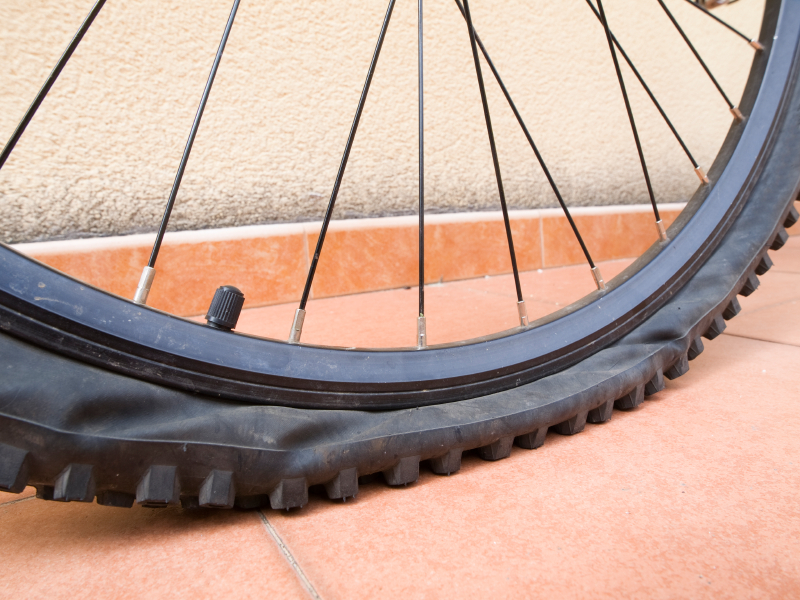
To help you understand and choose tires, we've prepared this guide. If you have any questions, please don't hesitate to visit the shop or contact us. We love talking tires!
Why Replace Tires?
There are two primary reasons:
1. The tires you have now are worn out.
2. You're not happy with how your bike rides or handles and you believe new rubber will help.
Identifying Worn-Out Tires
Tires wear out in a variety of ways, but a common sign that they should be replaced is a sudden rash of flat tires — several in a week, for example. This can happen when a tire is worn out because the tread is so thin it can no longer protect the tube from sharp objects you run over.
You can prevent the hassle of frequent flats by checking your tires when they're new so you recognize what good tread looks like. Inspect the depth of the grooves in the tire and then keep an eye on your tread checking before every ride. When the grooves begin to disappear, it's time to replace the tires.
When the grooves begin to disappear, it's time to replace the tires.
For most road models, this occurs in the range of 1,500 to 3,000 miles for rear tires, which wear much more quickly than fronts because 60% or more of your weight is on that tire (the lighter you are, the longer your tires will wear). Front tires usually run for upwards of 2 to 4,000 miles.
Another sign of wear is squaring off, which is what happens to rear road tires as the top of the tread flattens with many miles. Tires aren't as fast when they've squared off and it's a sign that you need to keep an eye on it and replace it soon.
If you just keep riding on the tire, you'll wear through the tread and expose the threads of the casing
beneath it, a sure sign that a new tire is needed. This occurs on front and rear tires if you ride them long enough. At this point, if you continue riding on the tire, you're asking for trouble because the only thing keeping the tube inside is a the thin section of casing, which was not designed to contact the road and will wear much faster than the rubber tread.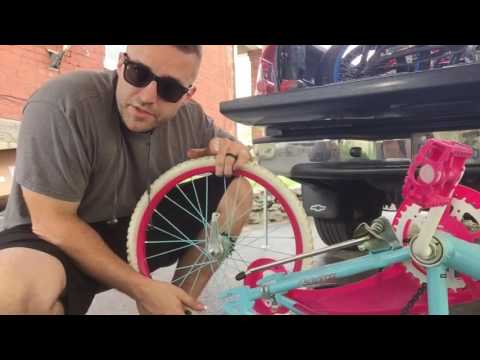
Tires wear with age, too. So, if you store a bike for some time, be sure to check the tires carefully. The tread won't have worn because you didn't ride the bike. But, it can harden and crack with age. More seriously, the casing (also called the "sidewall") can rot, crack and delaminate, too. If you see cracks, fraying casing threads and/or rotting, don't ride until you've replaced the tire(s) because while it may hold air, it won't for long and you could suffer a blowout, which can cause a crash.
| Tip: While the tires on a bicycle that's been stored for a month or more will probably be flat or very soft, it doesn't mean you need new tubes or tires. Tubes (which are inside tires and hold the air) lose air naturally over time, so in most cases, assuming the tires haven't decayed, you can simply inflate the tires and the bike will be ready to ride. |
Like road tires, mountain-bike tires are best evaluated by a trained eye based on how much tread they had when they were new.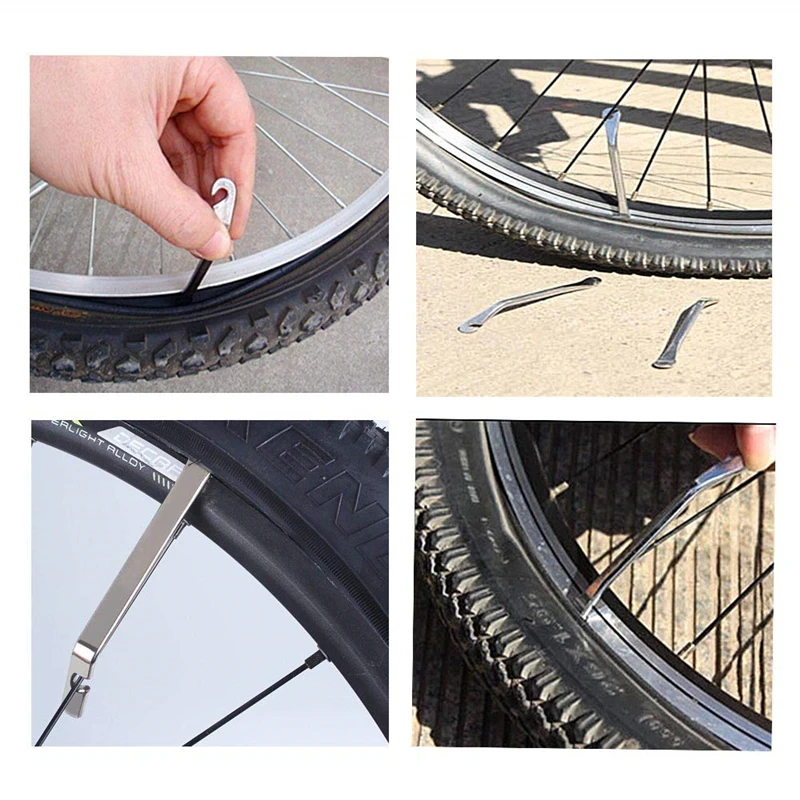 Another gauge is how they ride. As the knobs wear down, traction lessens and you'll feel this on climbs and in the corners. The smaller knobs also mean less protection for the tube, so it can lead to more flats, too. These are signs that it's time for new tires.
Another gauge is how they ride. As the knobs wear down, traction lessens and you'll feel this on climbs and in the corners. The smaller knobs also mean less protection for the tube, so it can lead to more flats, too. These are signs that it's time for new tires.
Replacing Tires To Improve Ride Quality
Sometimes, you'll want to replace perfectly good tires if they don't ride the way you like. This is a common practice for off-road riders requiring a certain type of ride for the challenges of a particular course. For example, a downhiller uses a different tire than a cross-country rider.
Similarly, if you have heavy, durable tires and tubes on a road bike and you want to keep up with some fast friends, an easy way to make your bike climb, corner and accelerate faster with less effort is to upgrade to lighter tires designed for faster riding.
We're bike-tire experts and if you have any questions about the condition of your tires or whether or not you'll benefit from upgrading to new ones, just ask us and we can make a recommendation.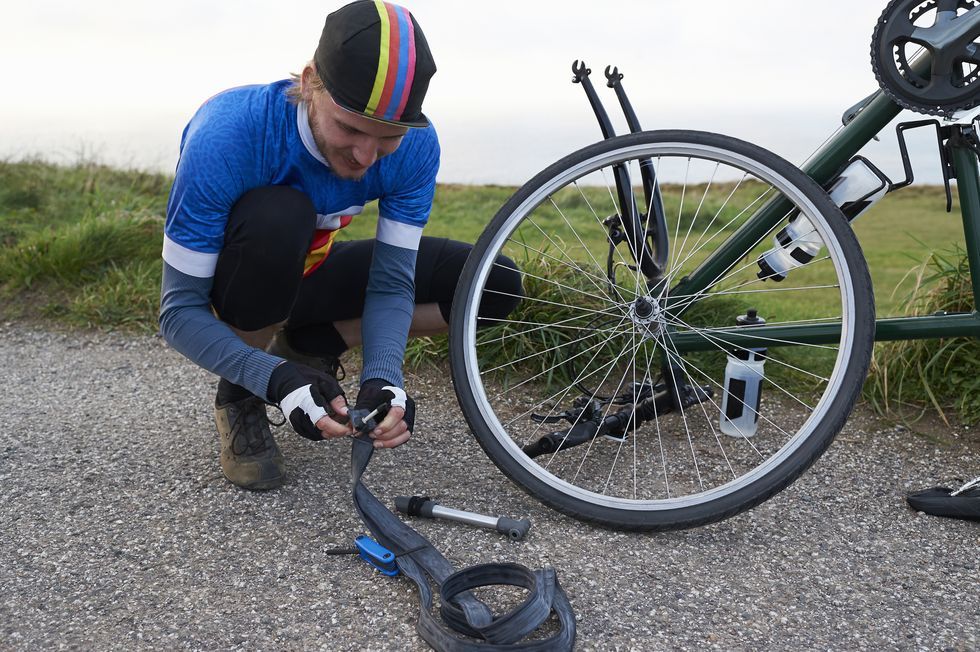
The Basics
Tire Types
Most bicycles today have tires with tubes inside. The tube is made of rubber, has a valve in it for inflation, and is just the right size and shape to fit inside the tire. When you inflate most tires, you are actually pumping air into the tube inside the tire, which fills the tire. Then, should you suffer a flat, you can simply remove the tire and replace or patch the tube to fix the problem.
The newest technology is found in tubeless tires, which are now available on certain mountain bikes and sometime soon, on road models, too. These tires are similar in design to automobile tires in that there's no tube inside. This works because the tire and rim act as a system to seal the tire and keep the air inside. The advantage of tubeless tires is the ability to run lower pressures with very little risk of flatting, even on extreme terrain. Plus, the softer tires provide more control and a smoother ride. This enhanced ride is complemented by the fact that because there's no tube, the tire is the only thing you feel, which means more compliance and a velvety-smooth ride. While these tires require special repair kits, they are less puncture prone than conventional skins.
This enhanced ride is complemented by the fact that because there's no tube, the tire is the only thing you feel, which means more compliance and a velvety-smooth ride. While these tires require special repair kits, they are less puncture prone than conventional skins.
The third type of tire, is called a tubular or sew-up. These are specialty tires found on high-end road bikes and designed mainly for racing. They are called tubular because they have a round, tubular profile. And they're called sew-ups because they're sewn together at the belly of the tube to give them the round profile (illustration).
There is a tube inside and to fix a flat you must cut the threads, extract the tube, patch the hole and then sew up the tire again! Tubulars require a special rim with a flat surface on top because the tires are glued onto the rims during installation. When you get a flat, you don't repair the tire on the road. You simply peel off the bad tire and install your spare.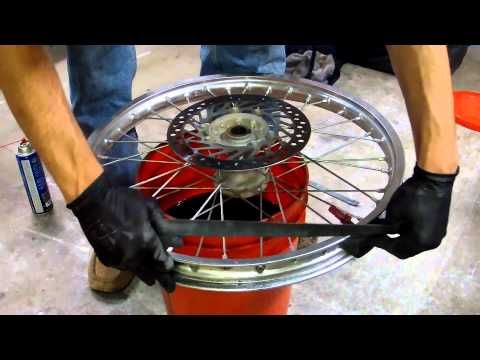
The reason racers like tubulars is because their round profile provides a super-supple ride that prevents much of the road shock from reaching the rider. Also, tubular rims and tires are lighter than conventional tires, which means slightly better acceleration, climbing and sprinting. And, because the tires are round, tubulars corner a little better than other racing tires, too.
Tire Sizing
When you need new tires, the first thing to know is what size to get. To determine this, simply look at the side of your tire where you'll find a size marking or a tire label with the tire size on it. Common sizes include 26 x 1.5; 26 x 2.0; 700 x 25c and 27 x 1 1/4.
Write this number down so you can tell us what size you have when you come in to select replacement tires (or if you prefer, simply bring in the old tire with you so we can match its size). The first number (for example, "26" or "700" or "27") indicates the tire and wheel diameter. The second number ("1. 5," "2.0," "25c," and "1 1/4") refers to the width of the tire as in 1.5 inches; 2.0 inches; 25mm; and 1 1/4 inches; and so on.
5," "2.0," "25c," and "1 1/4") refers to the width of the tire as in 1.5 inches; 2.0 inches; 25mm; and 1 1/4 inches; and so on.
| Tip: Don't be confused by the road bike tire designation "c" as in the size 700 x 25c. The "c" is just a French tire size, it does not stand for a numerical measurement. |
When shopping for tires, you must match diameters, so if you have 26-inch wheels, only 26-inch tires will fit. You can usually change widths if you want, however. And this is a good way to change the ride quality, too. For example, switching from a 26 x 1.5 tire to a 2.0 model puts you on a wider tire that holds more air, which you might like for more comfort, traction and control. Conversely, a roadie might switch from 700 x 28c tires to 23c tires to save a little weight for easier climbing and faster acceleration. While, if you were suffering frequent flats and a rough ride on narrow tires, you'd benefit by switching to wider tires for more protection and comfort
Keep in mind that not all rims and bike frames accept all possible tire widths.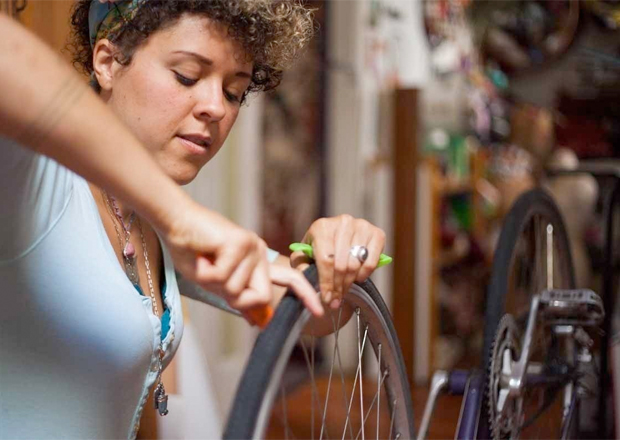 Usually going up or down one or two widths will work. If you're considering a big jump up or down, give us a call so we can make sure your rims and frame will accept the change without problems.
Usually going up or down one or two widths will work. If you're considering a big jump up or down, give us a call so we can make sure your rims and frame will accept the change without problems.
Directional Tires
Mountain bike tires are sometimes offered with directional tread. These rear- and front-specific designs offer optimum handling, traction and control based on the different functions the wheels serve. Directional tires are marked to tell you which wheel they belong on and in which direction the tread should be mounted. Assuming you like the way your bike handles, look for these markings before you replace tires so you know which new knobbies to get. And, be sure to install the new tires correctly.
Tip: If you plan to ride your off-road bike in an on-road event, such as a charity ride or century, you can make your bike almost as fast as a true road bike simply by changing the tires to narrow road models.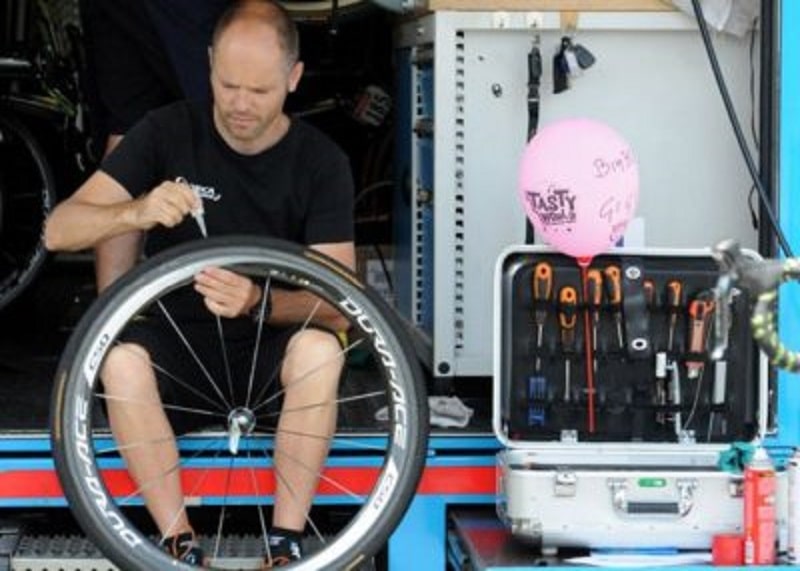 Most mountain bikes are equipped with knobby 26 x 2-inch tires, which roll poorly on pavement. By switching to 26 x 1-inch or 1.25-inch slick road tires (you'll need new tubes, too), you'll fly down the road! Most mountain bikes are equipped with knobby 26 x 2-inch tires, which roll poorly on pavement. By switching to 26 x 1-inch or 1.25-inch slick road tires (you'll need new tubes, too), you'll fly down the road! |
Selecting Tires
The illustration above shows the basic components that make up modern tires. The differences in how tires are constructed determines ride quality and the price range of the tire as the more features it has, the more difficult it is to manufacture. Here's a rundown of the common features with tips on how to choose.
Beads
The beads are the parts of the tire that grip the rim when the tire is inflated to keep the tire in place. At lower price points, tires come with wire beads made of steel. As you spend more, tires feature flexible beads made of synthetic materials, such as Kevlar, a DuPont material also used in bulletproof vests (more about Kevlar later). Tires with flexible beads are called "folding tires" because the beads allow the tire to be folded (wire-bead tires can only be folded partially).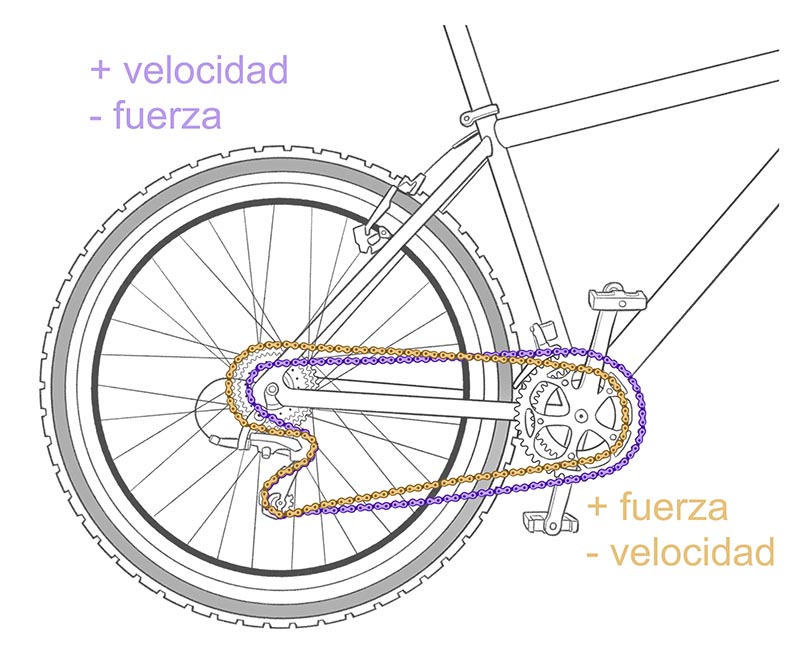 They're also called "Kevlar bead tires." Besides saving weight, Kevlar beads usually make tires a bit easier to install and remove, too.
They're also called "Kevlar bead tires." Besides saving weight, Kevlar beads usually make tires a bit easier to install and remove, too.
How to choose: If you want the best, get folding tires because they're lighter, which makes your bike easier to ride. If you want a good tire at a sweet price, you can usually get top tire designs for less simply by buying the version with wire beads.
Casing
The casing is the fabric that forms the basic structure of the tire. The material that's used, the number of threads per inch (TPI), and the design affect how a tire feels and handles.
How to choose: As a general rule, the higher the thread count, the more flexible and supple a tire will feel, which improves ride quality, handling and control. It also increases cost. If you're looking for protection from flat tires, some tires have reinforced sidewalls designed to help prevent punctures.
Sub-Tread
Not all tires have sub-treads.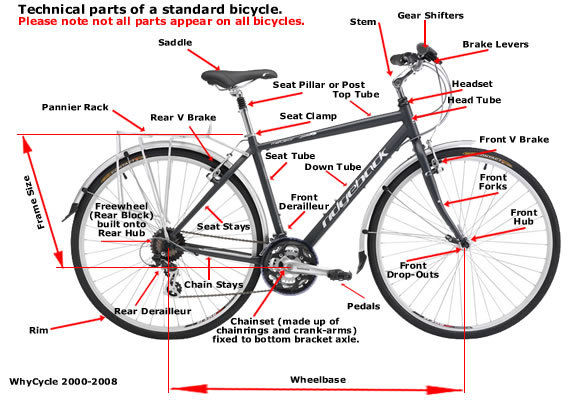 They're a common feature on tires designed with additional puncture protection. For example, an additional Kevlar or nylon layer will be placed in the tire beneath the tread to stop sharp objects from being able to puncture the tube. Tires equipped with protective sub-treads will be labeled as such.
They're a common feature on tires designed with additional puncture protection. For example, an additional Kevlar or nylon layer will be placed in the tire beneath the tread to stop sharp objects from being able to puncture the tube. Tires equipped with protective sub-treads will be labeled as such.
How to choose: If you suffer lots of flats due to the roads or conditions you ride in, getting tires with protective sub treads makes a lot of sense. Ditto if you only puncture occasionally, but hate dealing with flats. The only drawback is a little additional weight, which racers and fast riders might not want.
Tip: Getting the right tires will go a long ways towards preventing flats. We also offer tubes and accessories to protect you from punctures, plus tools to make the occasional repair as easy as possible. If flat tires are ruining your cycling experience please give us a call. We can help! We can help! |
Tread
The tread is the rubber that meets the road or trail. On road tires more tread usually means increased wear along with additional weight, so it's a tradeoff whether you require top ride quality or durability. Road tread varies in hardness, too, with harder rubbers wearing longer while softer compounds grip better in corners. These are fine distinctions widely debated among riders. You'll even find tires with dual-compound tread designed for good wear and top traction. And tread specifically designed for wet roads, as well.
For off-road riding, the amount of tread and the pattern of the tread determine the ride quality, traction and control. Manufacturers strive to design tread that provides the exact handling and characteristics for the different types of off-road terrain, riding and conditions. For example, if you ride in the mud and snow, there are tires designed specifically for these conditions.
How to choose: What's best has mostly to do with how and where you ride so if you can tell us that, we can point out some of our most popular tires for different types of riding. Another way to determine which tires are right is to ask friends you ride with who may have found models they recommend.
Another way to determine which tires are right is to ask friends you ride with who may have found models they recommend.
We hope these tips help and we look forward to seeing you when need new tires!
Special thanks to BikeMine, Continental and Vittoria Tires for supplying the great pictures.
We’ll help you understand how bike tires work by peeking beneath the surface, exploring its three core parts, and learning how each impacts ride quality and performance.
As we detail in How Bike Tires Are Made, the process involves multiple high-tech manufacturing processes. But, at their most basic, these rolling marvels involve just three core elements: the carcass, beads, and tread.
Here, we’ll zoom in, explore these components in detail, and see how they come together to make bicycle tires work.
Imagine picking up a bike tire and slicing through it with a pair of scissors, from one side to the other. If you looked at it head-on afterward, it would resemble an upside-down ‘U.’
The two endpoints—where the ‘U’ terminates—are cumulatively known as the tire’s beads, which TreadBikeShop.com and Maxxis explain are constructed from a continuous strand of one of two materials:
These strands—which Sheldon Brown refers to as “the “backbones” of a tire,” since they act as its main support structure and also determine it’s size, or diameter—are covered by a hard rubber compound for protection.
Then, they’re folded into the casing’s rubber by a tire building machine to form a wedge, which is what grips the rim and keeps the tire secured in place once the inner tube is filled with air.
How does air make its way into the inner tube?
Through a relatively simple device known as a valve stem, which uses a removable core and an elongated body to maintain proper pressure. Presta valves are longer and thinner than the much more common Schrader valve, and also feature a lock nut at the end to keep air inside, versus the latter’s internal spring.
Related: Bike Pump Buying Guide
In addition to spoke holes, bike rims feature a single larger hole through which the inner tube’s valve fits. Whether Presta or Schrader, these valves allow air to enter the tube, inflate the tire, and seat the beads into their grooves. ©TreadBikelyAlthough both steel wire and aramid fibers provide more than enough backbone support for most applications, there is a structural difference between the two materials: specifically, steel is rigid, whereas Kevlar fibers are flexible.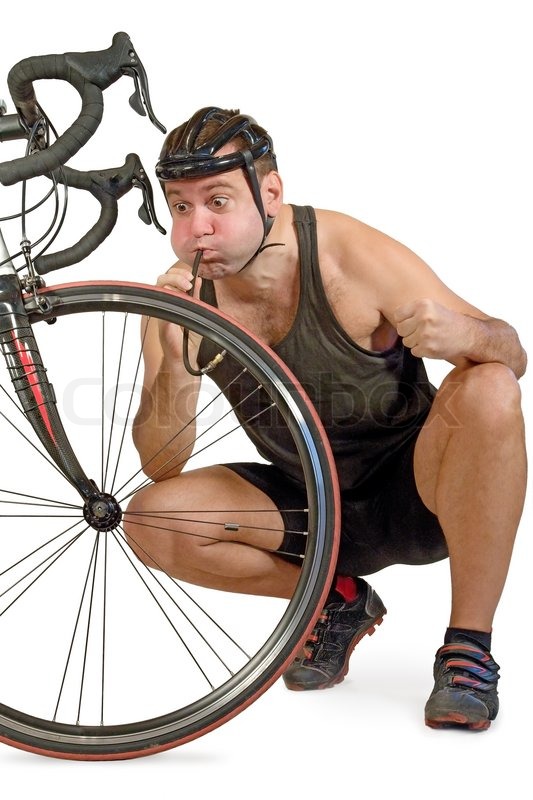
As a result, tires built with flexible beads are usually shipped folded, which has aptly given them a designation as ‘folding’ tires.
In addition to their flexibility, Johnny Sprockets points out that the flexible bead found in folding tires also typically makes them lighter, easier to install, and less-complicated to remove than their non-folding counterparts.
Bike tire beads made from synthetic fiber are more flexible than those made from steel wire, so they’re shipped folded from the manufacturer (as we can see in this popular model from Panaracer). Flexible beads also make folding tires lighter and easier to install and remove. Credit: TheBikesmiths.comA bike tire’s carcass references a network of cloth fabric—often made from nylon or other polyamides, although cotton and silk are used in some tire models—woven between each of its two beads.
Compared to regular cloth, which utilizes crossed threads, Sheldon Brown explains that a bike tire’s threads are arranged in layers of parallel threads, with each layer running perpendicular to the next at a 45-degree angle. Perhaps the easiest way to think of it is as a grid.
Perhaps the easiest way to think of it is as a grid.
When calendered to the tread’s rubber, it’s this layering and 45-degree angle application that’s responsible for a tire’s overall stability. Schwalbe adds that the density of the materials used to create casing mesh can also have a significant impact on a tire’s personality.
Together, while Mr. Brown refers to a tire’s beads as its backbone, he calls the carcass “the heart,” since it determines the shape and acts as the underlying framework.
A layered mesh network is bonded to casing rubber at a 45-degree angle, which governs a bike tire’s stability, overall feel, handling capabilities, control, and puncture resistance. ©TreadBikelyThe density of this mesh is measure in ‘ends per inch’ (EPI), also commonly referred to as ‘threads per inch’ (TPI), which references the number of threads contained in one square inch of casing.
In general, bike tires with lower TPI counts feature larger gauge threading and greater amounts of rubber in their casing mesh, resulting in heavier weights. Higher EPI tires, on the other hand, feature finer thread and a much closer mesh weave. What does this mean in the real world?
Higher EPI tires, on the other hand, feature finer thread and a much closer mesh weave. What does this mean in the real world?
According to Arlington Heights, IL-based Village Cycle Sport, “the higher the thread count, the more flexible and supple a tire will feel, which improves ride quality, handling, and control.” However, this will “also increase cost,” they emphasize.
As a general rule of thumb, mountain bike tires start at 60 TPI, while road tires typically begin somewhere around 120. REI tells us, however, that TPI count can go all the way up to 320.
If you encounter an EPI/TPI greater than 150, though, Schwalbe recommends exercising caution, since it’s often the case “the number of strands of all carcass layers is added together.”
For example, they explain, if a manufacturer advertises that one of their tires boasts 200 TPI, in reality, this could mean it’s constructed “from 3 layers of 67 EPI, each. ”
”
The third principal component is the tread, which refers to the exterior part of the tire that comes into contact with the ground.
Because it’s subject to the most significant amount of wear, tread rubber is extruded through a die during manufacturing so that it’s thicker in the center and thinner on the sidewalls (the area between the tread and each bead). The center section is also often grooved with different patterns to improve grip.
Tread is the outermost section of a bike tire, which is thicker in the center than on the sidewalls for improved resistance to wear. Grooves maximize surface adhesion. ©TreadBikelyDepending on the surface it’s designed for (pavement on the road, dirt on a trail, washed out gravel, smooth wood at a velodrome, etc.) the rubber compound manufacturers use to create a tire’s tread can have a significant impact on handling and performance characteristics. This is obviously in addition to attributes like casing mesh density and bead material.
This is obviously in addition to attributes like casing mesh density and bead material.
As just a couple of examples, harder rubber formulations provide greater resistance to wear, but can also reduce traction. Softer compounds, on the other hand, maximize traction (e.g., when cornering) but are prone to wear faster.
REI explains that dual-compound tires attempt to offer the best of both worlds since they “feature a softer rubber on the outside that contacts the ground, and a harder rubber between the tread and the casing.” This results in “better grip and better cornering in almost any terrain.”
In addition to the tread’s rubber compound, its groove pattern and depth—which is determined by a specially designed mold during vulcanization—can play significant roles in overall performance, especially when it comes to traction.
At one end of the spectrum, there are slicks, which feature little-to-no perceptible grooving. These tires are often used for indoor racing, where riders focus on minimizing rolling resistance and maximizing speed.
At the other end of the spectrum are mountain and ‘fat’ bike tires, which feature much deeper grooving that’s spaced farther apart to maximize traction in loose, quickly-changing off-road conditions. These ‘knobbies’ greatly increase rolling resistance on smoother surfaces, though, and could actually slow down a rider.
Mountain bike tires are often referred to as ‘knobbies,’ due to their deep, widely-spaced tread patterns. To further boost off-road performance, these tires also tend to feature fewer threads per inch than stiffer, road-oriented tires, thereby delivering a suppler ride. ©TreadBikelyWhether on-road or off, some bike tires also feature an additional ‘sub-tread;’ an extra layer of Kevlar or nylon that’s inserted underneath the primary tread to help boost puncture resistance. However, the tradeoff is that this sub-layer also adds weight and increases rolling resistance.
Although a bike tire’s sub-tread adds a few grams, the puncture protection it provides can be worth its weight in gold, especially for off-road applications. ©TreadBikely
©TreadBikelyGiven these details, Johnny Sprockets admits that when it comes to finding a tread compound and pattern combo that meets your needs and preferences, it’s often “a tradeoff whether you require top ride quality or durability.”
Based on everything we’ve written about here, along with our in-depth illustrations, we can see that while it might look like a single piece of rubber from the outside, a bike tire consists of three core parts: the beads, the casing, and the tread.
Perhaps more importantly, we can now understand how each of the materials and assembly processes used (e.g., beads made from steel wire vs. Kevlar fibers, threads-per-inch (TPI) measurement for casing mesh, and tread rubber compound) cumulatively contribute to a tire’s unique characteristics.
Keep rolling: Bike Tire Glossary
manufacturingreferencetire guidestires
Tubeless tires can hardly be called the know-how of the bicycle industry, however, they still raise questions for many. The topic itself, as a rule, is surrounded by a lot of skepticism and distrust, which are more often explained by a lack of understanding of basic things and a lack of experience in riding such wheels. To dispel all these doubts, we answer the main questions related to tubeless technologies.
The topic itself, as a rule, is surrounded by a lot of skepticism and distrust, which are more often explained by a lack of understanding of basic things and a lack of experience in riding such wheels. To dispel all these doubts, we answer the main questions related to tubeless technologies.
These are bicycle tires that do not have a tube. At the same time, tubeless technology is not only about tires. We are talking about a whole wheel system, which also includes a special rim and a sealant that gives the wheel anti-puncture properties. The tubeless concept makes the bike more comfortable to use and improves its riding performance, which will be discussed in order. nine0003
How long ago did this technology appear and can it be trusted?
Those who hear about bicycle tubeless for the first time usually tend to be suspicious of them. You can dislike this technology for subjective reasons, but you definitely shouldn’t distrust it. Tubeless tubes have been massively used for cars and motorcycles for several decades, and during this time they have not given reason to doubt their reliability.
Tubeless tubes have been massively used for cars and motorcycles for several decades, and during this time they have not given reason to doubt their reliability.
The first tubeless systems for bicycles appeared in 1999, when the French rim brand MAVIC, in collaboration with tire manufacturer Hutchinson, presented their concept of a simple and effective tubeless wheel. In the 2000s, this technology remained the prerogative of mainly professional athletes, who quickly appreciated its main advantages: lighter weight, more air in the wheel, good "traction" and durability.
In recent years, tubeless has finally ceased to be perceived as something exotic. For example, today a significant part of the MTB and almost all touring cars come with such wheels as standard. A wide variety of sealants are also available on the market, and the number of those who are discovering the benefits of tubeless technology is steadily increasing. nine0003
The tubeless system provides a special rim and tires that are labeled tubeless ready or TR. However, the rims themselves are easy to distinguish visually - they have a low side and characteristic walls with recesses, forming a kind of lock in which the tire cord is wedged when air is injected. Due to this, in the inflated state, the rubber reliably and hermetically “sits” on the rim, without breaking off the wheel even at low pressure. The rim itself is additionally glued with a sealing tape, after which the nipples are installed separately. nine0003
However, the rims themselves are easy to distinguish visually - they have a low side and characteristic walls with recesses, forming a kind of lock in which the tire cord is wedged when air is injected. Due to this, in the inflated state, the rubber reliably and hermetically “sits” on the rim, without breaking off the wheel even at low pressure. The rim itself is additionally glued with a sealing tape, after which the nipples are installed separately. nine0003
The benefits of tubeless wheels are revealed no matter how often and what kind of bike you ride: whether it's weekend trips, extreme downhill or long-distance touring. Nevertheless, for certain categories of cyclists tubeless still open up more opportunities: first of all, we are talking about those who are seriously passionate about off-road.
When actively driving off-road with tubeless tubes, you can ride on lowered wheels and at the same time not be afraid of such an unpleasant type of puncture as a snake bite. Low tire pressure, in turn, gives better handling, dampens vibrations more effectively and generally provides more comfort on difficult tracks. If we are talking about cyclists, then they appreciate tubeless for their anti-puncture qualities. nine0003
Low tire pressure, in turn, gives better handling, dampens vibrations more effectively and generally provides more comfort on difficult tracks. If we are talking about cyclists, then they appreciate tubeless for their anti-puncture qualities. nine0003
Road bikes also use tubeless wheels. Moreover, they are the pioneers of this technology. But road tubeless tubes are a different story: they are designed for different operating pressures and have tangible design differences. Therefore, further we will talk mainly about those tires that are put on mountain, touring and city bikes.
These are the two rim formats that define the features of a tubeless wheel assembly. BST is a standard that involves the installation of a special sealing tape that prevents air from leaking through the holes in the spokes. This is the most common version of tubeless systems. nine0003
UST is a blind rim in which an additional bridge isolates the spoke holes.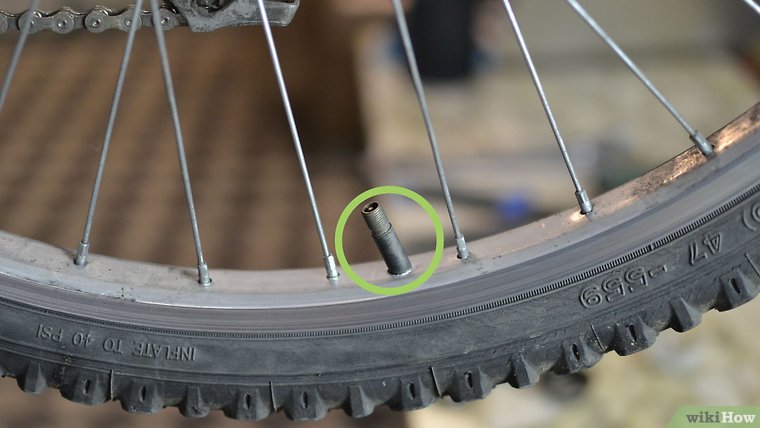 Thus, there is no need for laying a sealing tape. In practice, this greatly simplifies life, because when installing a tire (especially without proper experience), the tape tends to crush, which is why you have to reassemble the wheel. It is easy to guess that such rims also have a drawback - their price.
Thus, there is no need for laying a sealing tape. In practice, this greatly simplifies life, because when installing a tire (especially without proper experience), the tape tends to crush, which is why you have to reassemble the wheel. It is easy to guess that such rims also have a drawback - their price.
The tubeless system in the form in which we wrote it above is already a full-fledged wheel, it can be installed on a bicycle and hit the road. But there is an important nuance. First of all, tubeless tubes are valued for their anti-puncture qualities: for this, a small amount of a special liquid, a sealant, is poured inside the tire. nine0003
Yes, you can. But you should not do this. Firstly, this is illogical: for no reason you are depriving yourself of the main advantage of tubeless - the anti-puncture effect. But more importantly, it is very difficult (or even impossible) to inflate such a tire in a completely flat state with a portable pump: to do this, you need either a strong floor pump or a booster. Naturally, no one will take such bulky things with them on the road. Filled with sealant 95% of punctures "seal" without a critical loss of pressure, and in most cases there is no need for even light pumping. Thus, the probability of being with a flat tire is very low.
Naturally, no one will take such bulky things with them on the road. Filled with sealant 95% of punctures "seal" without a critical loss of pressure, and in most cases there is no need for even light pumping. Thus, the probability of being with a flat tire is very low.
So, if you put tubeless, sealant is still needed. Such fluids are easy to find in any bike shop, they are inexpensive and require replacement on average once every three to four months, so there is no need to talk about any inconvenience. Yes, in order to cope with the fill, you need to acquire a certain skill, but this is much easier than constantly changing broken cameras. In addition, sealant can be replaced once a season in a specialized service. nine0003
Bicycle sealants are based on fine particles (rubber or polymer fibers) suspended in a liquid carrier. Inside the wheel, the sealant does not polymerize: it is in a liquid state and is distributed along the inside of the tire during movement. When a puncture occurs, the air flow begins to push the solution out. A fine suspension clogs the hole, and the sealant dries quickly. Thus, there is a reliable "sealing" of the puncture. nine0003
When a puncture occurs, the air flow begins to push the solution out. A fine suspension clogs the hole, and the sealant dries quickly. Thus, there is a reliable "sealing" of the puncture. nine0003
If we talk about typical punctures - collisions with thorns, wires, small glasses - such damage is self-healing without a noticeable loss of pressure. Usually, a puncture can only be guessed from a small spot on the surface of the tire. Naturally, the sealant works with more complex damage. You can count on it even if you pierce the wheel with a thick nail, 4-5 mm in diameter. If you don't understand how a liquid can seal such holes, you can watch numerous crash tests on YouTube that demonstrate the miraculous properties of sealants. nine0003
The consumption per tire is from 50 to 100 ml. If we are talking about standard MTV tires, the golden mean is about 60 ml per wheel. The exact dosage will always be written on the bottle. It is difficult to get confused even for those who do not like to read instructions: most sealants have measuring containers or a dosage scale on the bottle itself.
It is difficult to get confused even for those who do not like to read instructions: most sealants have measuring containers or a dosage scale on the bottle itself.
Here, too, everything is conditional and depends on the characteristics of the specific composition and intensity of punctures. In the absence of serious damage that entails the leakage of a large volume of sealant, you can easily skate a whole season on one fill. Some cyclists prefer to do an incomplete start-up gas station and gradually add 20-30 ml of fluid every two to three months. You can also navigate by how effectively the sealant works: if you see that small punctures are sealed with a strong deflation of the wheel, it may be that the composition is no longer enough and it needs to be added. Be that as it may, sealant is a very economical thing that lasts for a long time. nine0003
The sealant inside the tubeless tends to dry out, forming a characteristic film..jpg) Whether or not to clean the tire cavity is up to you. This is a purely aesthetic moment, which does not affect the operation of the anti-puncture fluid. The sealant can simply be added as it dries and not bother with unnecessary worries. It is more likely that the tire will completely wear out than it will have time to completely clog with dried filler.
Whether or not to clean the tire cavity is up to you. This is a purely aesthetic moment, which does not affect the operation of the anti-puncture fluid. The sealant can simply be added as it dries and not bother with unnecessary worries. It is more likely that the tire will completely wear out than it will have time to completely clog with dried filler.
nine0063
Serious damage - large diameter punctures, small cuts, run over nails with subsequent tire rupture - are repaired using special repair worms. These are rubber or fibrous bands that are inserted into the hole to reduce its area and allow the sealant to seal the puncture.
With long longitudinal cuts it is more difficult. Here you need to either sew up the dissection with nylon threads, or stick a patch on the inside of the tire. You don’t have to worry about the tightness of the repair site - the sealant will do this work, of course, if it does not have time to leak out. But being able to inflate a completely flat tire with only a portable pump will require skill. nine0003
But being able to inflate a completely flat tire with only a portable pump will require skill. nine0003
In fairness, we note that such complex injuries are rare for most cyclists. But for those who are seriously passionate about off-road, it is better to play it safe with a spare camera. In this case, having caught a cut, you can always drain the sealant, unscrew the nipple from the rim and install a regular camera. And in order not to drive with a “hernia” protruding outward, we recommend placing, for example, a bill folded in half under the cut on the tire.
Tubeless allows you to forget about such an unpleasant form of damage as a "snake bite" forever. It usually happens when at full speed you catch a pothole in the pavement, unsuccessfully jump onto a curb or run into a stone on a downhill. Hitting the edge of a hard object, the tire is crushed, and the rim walls work like incisors, damaging the chamber in two places. In tubeless wheels, this scenario is excluded, because. there is nothing to break through here. Of course, it can be assumed that the rim will cut the tire itself, but this should be a blow of enormous force, which is almost never encountered in practice. nine0003
In tubeless wheels, this scenario is excluded, because. there is nothing to break through here. Of course, it can be assumed that the rim will cut the tire itself, but this should be a blow of enormous force, which is almost never encountered in practice. nine0003
Rejection of the chamber increases the amount of air in the wheel. This changes the contact patch (it becomes flatter) and allows the wheels to better absorb off-road bumps. Add here the ability to ride at low pressure, without being afraid of a snake bite, and it becomes completely clear why tubeless lovers of hard off-road riding so idolize. Soft tires with a large contact patch "fit" all the bumps in the road, giving excellent traction on rocks, forest primers and other off-road. nine0003
In addition to traction, tubeless tires improve shock absorption, dampen vibrations better, and generally provide more off-road comfort. At the same time, to get the most out of this rubber, you need to experiment a lot with tire pressure, trying to find the indicators that will best suit your individual riding style.
Finally, the camera is extra grams. By refusing them, you can save an average of 70-100 g of weight on each wheel. For some, this may seem like a formality, but it is worth considering the fact that extra grams on the periphery of the wheel have a stronger effect on driving performance. This difference is especially felt on road bikes: road bikes, gravel, touring. nine0003
They also exist. Moreover, it is far from formal. First, it's the price. The difference becomes especially noticeable when you buy tubeless systems separately: rims, tires + small things (tape, removable nipples, sealant). For tubeless you will have to pay an average of one and a half times more than for ordinary wheels, plus or minus the same class. And if we are talking about more advanced UST rims, then this means another + 30-40% to the cost.
With tubeless by default, everything is more difficult in terms of installation (here we are talking about conventional BST systems).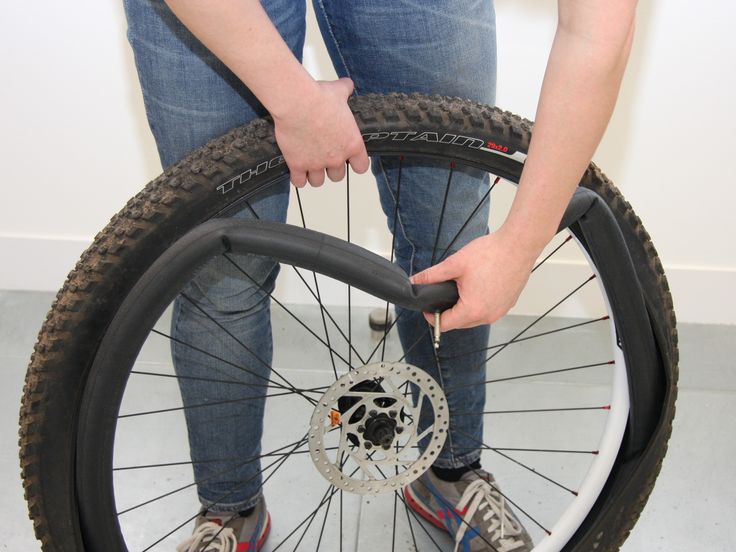 You need to learn how to properly glue the tape, accurately insert the nipples, carefully install tight rubber, making sure not to displace the tape and not fill everything with sealant. On the other hand, all this comes with experience, but what you will always have to put up with is the difficulty with pumping a completely flat tire.
You need to learn how to properly glue the tape, accurately insert the nipples, carefully install tight rubber, making sure not to displace the tape and not fill everything with sealant. On the other hand, all this comes with experience, but what you will always have to put up with is the difficulty with pumping a completely flat tire.
A tubeless tube cannot be inflated until its landing board snaps into place on the rim. To do this, you need to sharply introduce air into the tire. The tire should straighten up and fall into the grooves with a characteristic click - then it can be safely pumped further. This all sounds simple if there is a compressor in the garage. Putting a tubeless tube into the grooves by pumping air with an ordinary floor pump is quite difficult, and almost impossible with a portable bicycle pump. nine0003
All this makes life much more difficult. But there are solutions. In the field, a compact can of compressed air can help out. At home, installing tubeless tubes greatly simplifies the booster. This is a cylinder into which a high pressure is pumped with a pump, then it is connected to a nipple, the valve is lowered - and the air from the reservoir pumps up the wheel sharply.
This is a cylinder into which a high pressure is pumped with a pump, then it is connected to a nipple, the valve is lowered - and the air from the reservoir pumps up the wheel sharply.
As you can see, tubeless cameras also have enough disadvantages, but it is wrong to consider them in isolation from the advantages. For example, the probability of being with a completely flat tire away from home is very low, due to the anti-puncture qualities. Complicated installation is offset by the lack of punctures and roadside repairs. And by overpaying in price, you save on interchangeable cameras, and, of course, win as a roll on off-road. nine0003
December 15, 2015
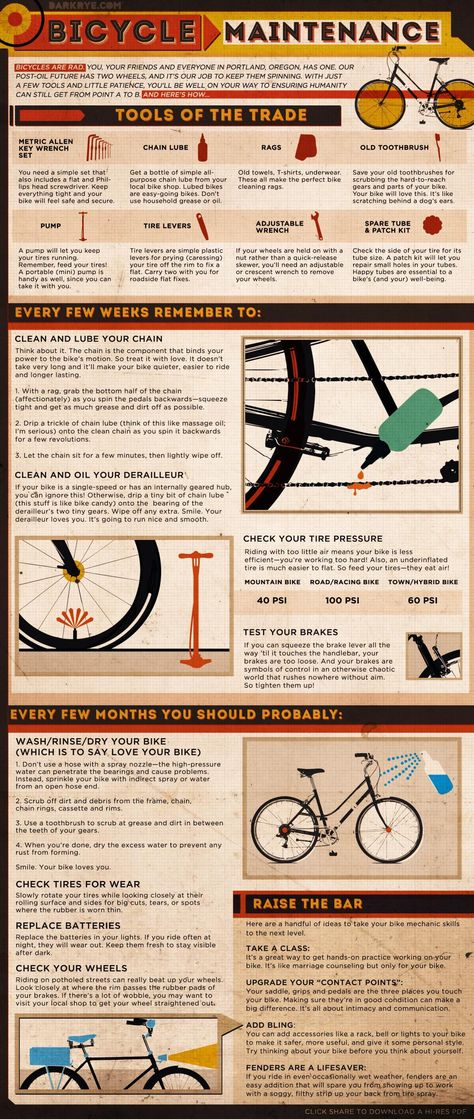
You ride every day and you need tires with good wear resistance and puncture protection, or your element of cross-country and your bike no longer remembers the last time you went from mud to asphalt, or you are a person who rides quite rarely and before What do you value most about travel comfort? Completely different types of tires will cope with each of these tasks. nine0003
Tire design:
Bicycle tire manufacturers strive to surprise the buyer with new technologies or materials, but the basic structure of a bicycle tire remains unchanged:
The outer shell of the tire is made of rubber or compound. Rubber is obtained from rubber, which is extracted from the sap of rubber trees - such rubber is too expensive, so synthetic rubber is mainly used. Sulfur must be added to turn rubber into rubber. This process is called vulcanization. The resulting material is stronger and more elastic than raw rubber. To enhance strength, fibers are added to rubber, such as in the production of car tires.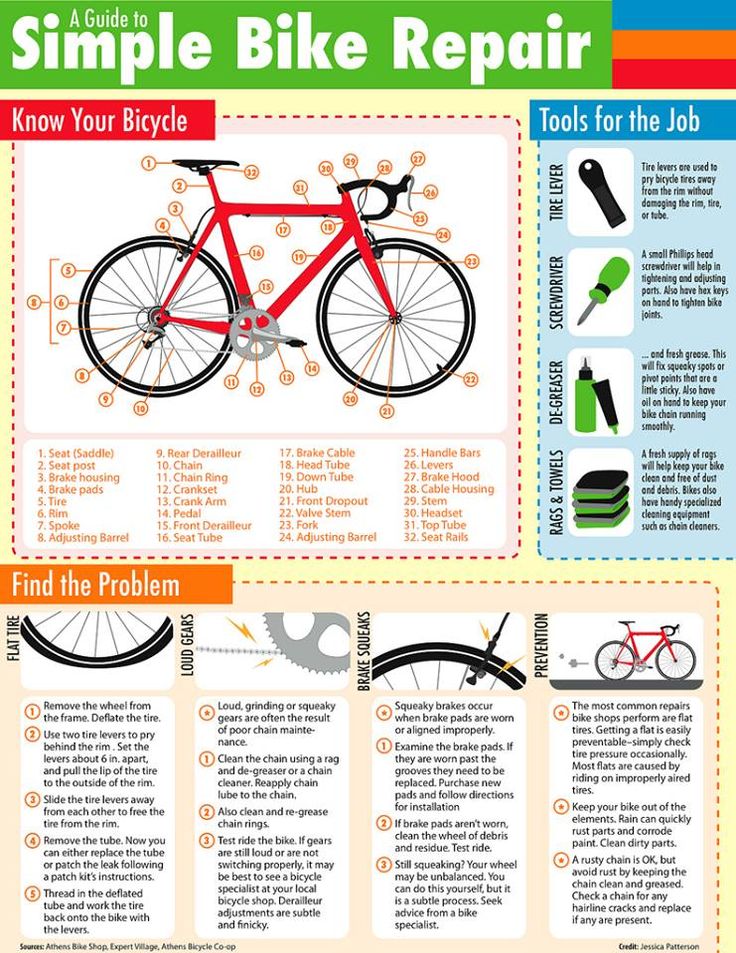 Oil and gasoline resistant rubber can only be made from synthetic rubber. The main properties of the tire depend on natural or synthetic rubber, the most important component of rubber. To improve the properties of rubber, in addition to rubber, dyes, vulcanizers, plasticizers, stabilizers, hardeners and other components are added to the composition. Fillers degrade the quality of the rubber, but they also reduce the price. The shape of the tire depends on the fabric base. It consists of several parallel layers of fibers stretched between the sides of the "rubber". Fibers are made from various synthetic materials. Compounds are the basis of various polymers and monomers. They are cheaper to manufacture than rubber, but their properties are ahead of synthetic rubber (they have less rolling resistance, which means better rolling). nine0003
Oil and gasoline resistant rubber can only be made from synthetic rubber. The main properties of the tire depend on natural or synthetic rubber, the most important component of rubber. To improve the properties of rubber, in addition to rubber, dyes, vulcanizers, plasticizers, stabilizers, hardeners and other components are added to the composition. Fillers degrade the quality of the rubber, but they also reduce the price. The shape of the tire depends on the fabric base. It consists of several parallel layers of fibers stretched between the sides of the "rubber". Fibers are made from various synthetic materials. Compounds are the basis of various polymers and monomers. They are cheaper to manufacture than rubber, but their properties are ahead of synthetic rubber (they have less rolling resistance, which means better rolling). nine0003
To find out what material the tire is made of, you need to run a dry finger over the tire: the rubber will reach for the finger, and the compound will remain in place. That's probably all you need to know about the design of tires. And every day more and more rubber modifications appear in the world of bicycles: with a double compound, with an additional cord, with a reflective tape, etc. But there are quite a lot of technologies and listing them all is quite a long task. I can only advise you - if you have already decided to buy a tire with some kind of individual technology, you should contact the dealer center of this manufacturer directly and consult with him, find out as much as possible, make sure that this is not just a marketing ploy and then make a decision. nine0003
That's probably all you need to know about the design of tires. And every day more and more rubber modifications appear in the world of bicycles: with a double compound, with an additional cord, with a reflective tape, etc. But there are quite a lot of technologies and listing them all is quite a long task. I can only advise you - if you have already decided to buy a tire with some kind of individual technology, you should contact the dealer center of this manufacturer directly and consult with him, find out as much as possible, make sure that this is not just a marketing ploy and then make a decision. nine0003
We also want to remind you that our store has a service center for repair and maintenance of bicycles.
If you are unable to eliminate the creak, crunch, crackle or any other malfunction of your iron horse yourself - do not worry, we will help you with this.
And don't worry about the complexity of the repair. We do work of any complexity - from the installation of small accessories, to the most complex technical work.